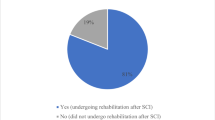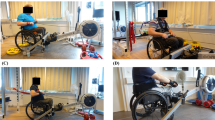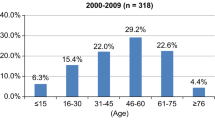Abstract
Study design:
This was a retrospective observational study.
Objective:
The objective was to determine the normative values for 20 min exercise of wheelchair propulsion in spinal cord injury (SCI) subjects.
Setting:
Sarah Rehabilitation Hospitals Network, Brazil.
Methods:
A total of 413 medical records for SCI patients at different levels and classifications at the Sarah Rehabilitation Hospitals Network, Brazil, who performed 20 min exercise in a rehabilitation programme between the years 2004 and 2009 were consulted. Information regarding patient and performance characteristics was obtained, including distance travelled, mean velocity, rest and exercising heart rate and perceived exertion. The data were analysed by gender and by injury level group: tetraplegia (TT) or paraplegia (PP).
Results:
The participants’ ages ranged from 18 to 64 years, and the median time since injury was 1.2 years. The men and women had different performances regardless of their level of injury. The distance ranged between 495 and 2106 m for men and between 300 and 1901 m for women. The mean velocity of propulsion ranged from 25 to 105 m min−1 for men and from 15 to 95 m min−1 for women.
Conclusions:
This study provides normative data for the 20 min exercise that could be used to estimate the resistance capacity by manual wheelchair users with SCI and evaluate the effects of training and other therapeutic interventions.
Similar content being viewed by others
Log in or create a free account to read this content
Gain free access to this article, as well as selected content from this journal and more on nature.com
or
References
Beekman CE, Miller-Porter L, Schoneberger M . Energy cost of propulsion in standard and ultralight wheelchairs in people with spinal cord injuries. Phys Ther 1999; 79: 146–158.
Haisma JA, van der Woude LH, Stam HJ, Bergen MP, Sluis TA, Bussmann JB . Physical capacity in wheelchair-dependent persons with a spinal cord injury: a critical review of the literature. Spinal Cord 2006; 44: 642–652.
Tawashy AE, Eng JJ, Krassioukov AV, Miller WC, Sproule S . Aerobic exercise during early rehabilitation for cervical spinal cord injury. Phys Ther 2010; 90: 427–437.
Hicks AL, Martin Ginis KA, Pelletier CA, Ditor DS, Foulon B, Wolfe DL . The effects of exercise training on physical capacity, strength, body composition and functional performance among adults with spinal cord injury: a systematic review. Spinal Cord 2011; 49: 1103–1127.
Dallmeijer AJ, van der Woude LH . Health related functional status in men with spinal cord injury: relationship with lesion level and endurance capacity. Spinal Cord 2001; 39: 577–583.
Vanlandewijck Y, van de Vliet P, Verellen J, Theisen D . Determinants of shuttle run performance in the prediction of peak VO2 in wheelchair users. Disabil Rehabil 2006; 28: 1259–1266.
Warburton DE, Eng JJ, Krassioukov A, Sproule S . Cardiovascular health and exercise rehabilitation in spinal cord injury. Top Spinal Cord Inj Rehabil 2007; 13: 98–122.
Ribeiro FN, Beraldo PSS . Reprodutibilidade e Responsividade dos Índices Baseados em Batimentos Cardíacos na Propulsão de Cadeira de Rodas em Indivíduos com Lesão Medular. Brasilia, Brazil, Postgraduate Rehabilitation Sciences. Sarah Rehabilitation Hospital Network. 2009.
Neto FR, Lopes GH . Body composition modifications in people with chronic spinal cord injury after supervised physical activity. J Spinal Cord Med 2011; 34: 586–593.
Scivoletto G, Morganti B, Ditunno P, Ditunno JF, Molinari M . Effects on age on spinal cord lesion patients’ rehabilitation. Spinal Cord 2003; 41: 457–464.
Wyndaele M, Wyndaele JJ . Incidence, prevalence and epidemiology of spinal cord injury: what learns a worldwide literature survey? Spinal Cord 2006; 44: 523–529.
Newsam CJ, Mulroy SJ, Gronley JK, Bontrager EL, Perry J . Temporal-spatial characteristics of wheelchair propulsion. Effects of level of spinal cord injury, terrain, and propulsion rate. Am J Phys Med Rehabil 1996; 75: 292–299.
Gutierrez DD, Mulroy SJ, Newsam CJ, Gronley JK, Perry J . Effect of fore-aft seat position on shoulder demands during wheelchair propulsion: part 2. An electromyographic analysis. J Spinal Cord Med 2005; 28: 222–229.
Hatchett PE, Requejo PS, Mulroy SJ, Haubert LL, Eberly VJ, Conners SG . Impact of gender on shoulder torque and manual wheelchair usage for individuals with paraplegia: a preliminary report. Top Spinal Cord Inj Rehabil 2009; 15: 79–89.
Kouda K, Furusawa K, Sugiyama H, Sumiya T, Ito T, Tajima F et al. Does 20-min arm crank ergometer exercise increase plasma interleukin-6 in individuals with cervical spinal cord injury? Eur J Appl Physiol 2011; 112: 597–604.
Goosey-Tolfrey V . Wheelchair Sport: A Complete Guide for Athletes, Coaches, and Teachers. Human Kinetics Publishers: Champaign, IL. 2010.
Hill K, Ellis P, Bernhardt J, Maggs P, Hull S . Balance and mobility outcomes for stroke patients: a comprehensive audit. Aust J Physiother 1997; 43: 173–180.
Robinett CS, Vondran MA . Functional ambulation velocity and distance requirements in rural and urban communities. A clinical report. Phys Ther 1988; 68: 1371–1373.
Andrews AW, Chinworth SA, Bourassa M, Garvin M, Benton D, Tanner S . Update on distance and velocity requirements for community ambulation. J Geriatr Phys Ther 2010; 33: 128–134.
Tolerico ML, Ding D, Cooper RA, Spaeth DM, Fitzgerald SG, Cooper R et al. Assessing mobility characteristics and activity levels of manual wheelchair users. J Rehabil Res Dev 2007; 44: 561–571.
Grange CC, Bougenot MP, Groslambert A, Tordi N, Rouillon JD . Perceived exertion and rehabilitation with wheelchair ergometer: comparison between patients with spinal cord injury and healthy subjects. Spinal Cord 2002; 40: 513–518.
Lewis JE, Nash MS, Hamm LF, Martins SC, Groah SL . The relationship between perceived exertion and physiologic indicators of stress during graded arm exercise in persons with spinal cord injuries. Arch Phys Med Rehabil 2007; 88: 1205–1211.
Bednarczyk JH, Sanderson DJ . Limitations of kinematics in the assessment of wheelchair propulsion in adults and children with spinal cord injury. Phys Ther 1995; 75: 281–289.
Sagawa Y Jr., Watelain E, Lepoutre FX, Thevenon A . Effects of wheelchair mass on the physiologic responses, perception of exertion, and performance during various simulated daily tasks. Arch Phys Med Rehabil 2010; 91: 1248–1254.
de Groot S, Dallmeijer AJ, Kilkens OJ, van Asbeck FW, Nene AV, Angenot EL et al. Course of gross mechanical efficiency in handrim wheelchair propulsion during rehabilitation of people with spinal cord injury: a prospective cohort study. Arch Phys Med Rehabil 2005; 86: 1452–1460.
Dallmeijer AJ, van der Woude LH, Hollander PA, Angenot EL . Physical performance in persons with spinal cord injuries after discharge from rehabilitation. Med Sci Sports Exerc 1999; 31: 1111–1117.
Acknowledgements
We thank the Physical Education staff of Sarah Network of Hospitals who gave us support and assistance in the development of this research.
Author information
Authors and Affiliations
Corresponding author
Ethics declarations
Competing interests
The authors declare no conflict of interest.
Rights and permissions
About this article
Cite this article
Coutinho, A., Neto, F. & Perna, C. Determination of normative values for 20 min exercise of wheelchair propulsion by spinal cord injury patients. Spinal Cord 51, 755–760 (2013). https://doi.org/10.1038/sc.2013.89
Received:
Revised:
Accepted:
Published:
Issue date:
DOI: https://doi.org/10.1038/sc.2013.89



